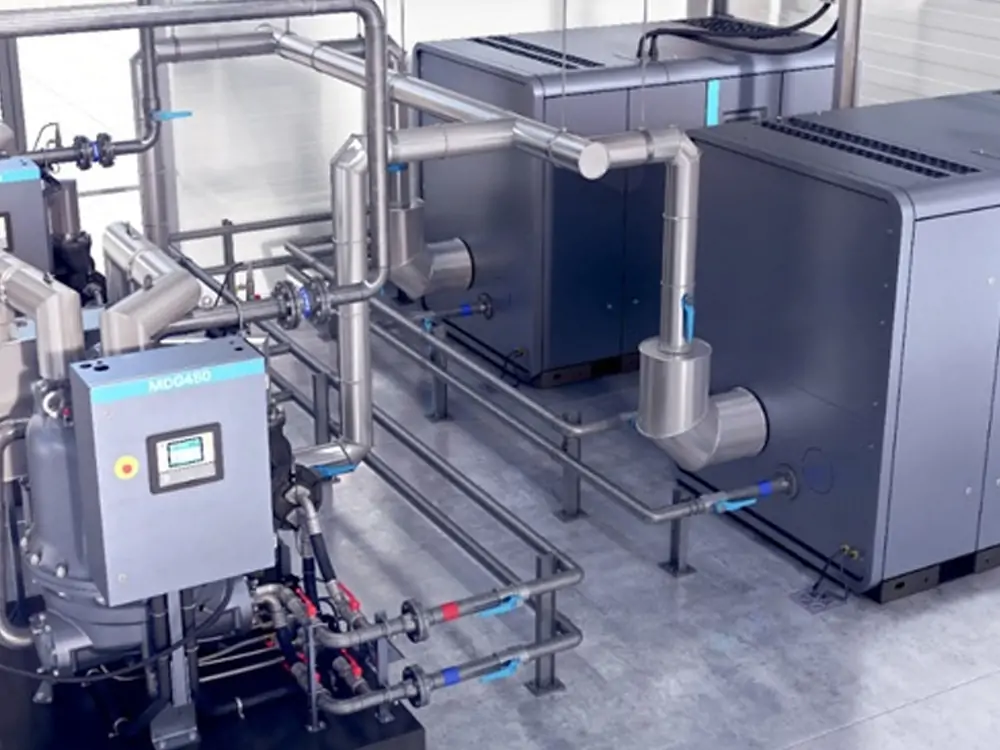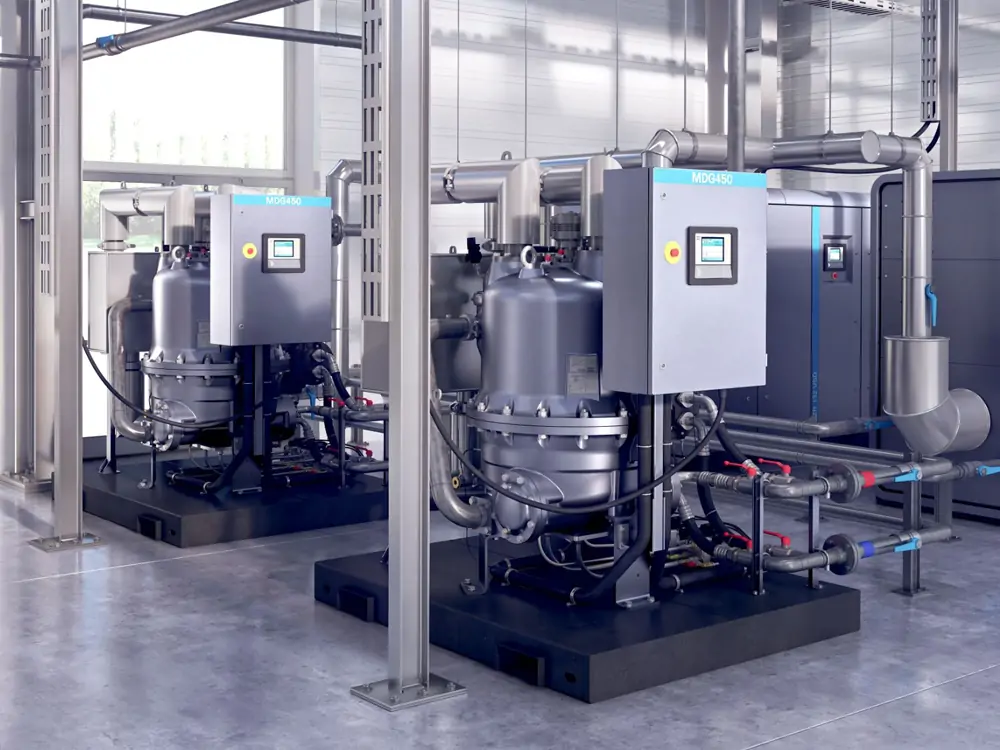O secador de compressor de ar é um elemento essencial dos sistemas de ar comprimido. Inevitavelmente, haverá umidade durante a operação do compressor de ar. It can contaminate the end product and damage our production equipment and components. This is why it must remove this moisture in the compressor system. Compressed air dryers are the devices that help dry the wet air. Isso garante a qualidade do seu ar comprimido. Mas para você, what is the best air dryer for air compressors? E como selecioná-los?
Whether you are an engineer, technician, or manufacturer, this article will provide in-depth insights and guidance on this critical topic. Let’s choose the right drying solution for your air compression system.
How Do You Select The Air Dryer For Air Compressor
It must know the following parameters to choose the right compressed air dryer. Let’s talk about it.
Capacidade de ar
The air compressor dryer can handle this maximum flow of compressed air. Primeiramente, the user needs to determine this value based on the consumption of all air-consuming equipment and the usage factor. Claro, se você já tem um compressor de ar, you can send the nameplate to the manufacturer.
As a professional air compressor dryer manufacturer, nós dizemos-lhe com responsabilidade. Se você usar muito ar, choose a compressed air dryer with a larger capacity. Aquilo é, a capacidade de ar do secador deve ser maior que a do compressor de ar. Porque em tempos de alta temperatura e umidade, o teor de água do ar aumenta. Neste momento, the dryer machine is overloaded. Então, the drying effect will decrease. Isso pode causar muitos problemas, como grandes quantidades de umidade e quebra de equipamentos.
Pressão de ar de entrada
Different air pressures and different air capacities of the dryer. As pressões comuns na produção industrial variam de 0,6 MPa a 1,0 MPa. Então, the most common is the normal pressure air compressor air dryer.
No entanto, outras indústrias têm requisitos de pressão diferentes. Por exemplo, a indústria de laser geralmente requer 16 bars. Some industries require high-pressure compressed air dryers. Nossa empresa pode personalizar secadores de até 100 bar.
Inlet Air Temperature And Ambient Temperature
A temperatura é crítica para a escolha do secador com compressor de ar. Por exemplo, existem dois tipos de secadores de ar refrigerados. Namely normal temperature (50°C) and high temperature (80°C). The temperature is very high in Pakistan and the Middle East in summer. First, it must choose a high-temperature type of refrigerant dryer. Além disso, muitas vezes precisamos escolher um modelo maior. This not only achieves good water removal but also avoids dryer downtime.
Por outro lado, a temperatura do ar de entrada do secador de ar dessecante geralmente não deve ser superior a 40°C. If the temperature is too high, o efeito de remoção de água do adsorvente será bastante reduzido. Claro, it can choose the HOC type desiccant dryer now.
Dew Point Requirement of Air Compressor Dryer
Different dew point requirements and different equipment configurations. Naturalmente, the price is different. Os secadores refrigerados geralmente têm um ponto de orvalho de pressão de 2 a 10°C. There are different conditions and different dew points. Por exemplo, refrigerant compressed air dryers can achieve a very low dew point. Mas requer uma condição operacional padrão de 25°C e 7 bar.
Diferentes indústrias têm requisitos diferentes para pontos de orvalho. A seguir estão alguns exemplos.
- Indústria farmacêutica: ponto de orvalho é de pelo menos -40°C.
- indústria de PCB: ponto de orvalho precisa atingir -20°C.
- Indústria de separação de gás e ar: ponto de orvalho deve ser -70°C.
Choose a combination dryer if you require a dew point of -70°C. Ou deve haver um secador de refrigeração e filtros antes do secador de ar de adsorção.
Voltage And Frequency
Varia de país para país. Por exemplo, na América do Norte, 220V/60HZ/monofásico e 380V/60HZ/trifásico são comuns. Neste momento, ele precisa personalizar o compressor de refrigerante. Às vezes, o preço do tintureiro também será diferente.
Raw Materials
Some industries have requirements for the material of air compressor dryers. Por exemplo, the pharmaceutical industry requires stainless steel. Nesse caso, a tubulação e o sistema de troca de calor devem ser SS304. E a torre de adsorção também precisa de SS304. Além disso, a indústria de baterias de lítio também requer aço inoxidável.
O secador de aço inoxidável será mais caro. Claro, you can choose the Lingyu PD series refrigerated air dryer. You can also choose the modular desiccant compressed air dryer. Eles também podem atender aos requisitos das indústrias alimentícia e farmacêutica.
Environmental Requirements
O refrigerante usual de secadores de ar refrigerante é R22. É comum em países em desenvolvimento. No entanto, Os países europeus e americanos exigem refrigerantes ecológicos. Para nós, R134a, R407C, R410a estão disponíveis. The dryer is a little more expensive if you want an eco-friendly refrigerant.
Air Cooled vs. Water Cooled Refrigerated Compressor Air Dryer
O secador de ar refrigerante de fluxo pequeno é refrigerado a ar. Nosso secador refrigerado a ar pode ter até 120 m³/min. Se acima 120 m³/min, the air compressor air dryer is water-cooled.
For high-flow dryers, the size will be very large if you need an air-cooled type. Por exemplo, será tão alto quanto vários andares. E a eficiência da troca de calor será muito pior. The water-cooled dryer is not affected by a high-temperature environment. Claro, there needs to be a cooling water system. Portanto, isso adicionará custos.
Energy Saving Requirements
① Fixed vs. Variable Frequency Refrigerated Air Dryer
We commonly use fixed-frequency air compressor dryers. Pode atender a saída máxima. No entanto, in actual production activities, a demanda de ar varia. Em pequenas demandas, ainda funciona na saída máxima. Isso leva a um desperdício de energia. Pelo contrário, the output of the variable frequency dryer can match the air demand. Isso resulta em economia significativa de custos de energia e operação.
② Choice of Desiccant Dryer Regeneration Method
The heatless compressed air dryer has a small power of ~0.1 kW. But it has a big air consumption of about 15%. Isso é alto consumo de energia. O secador dessecante microaquecido geralmente consome cerca de 8% de ar de regeneração. Em comparação com o secador sem calor, pode salvar 40% de energia.
O secador dessecante com perda de ar zero consome 0% ar de regeneração. A heatless air compressor air dryer can save 70% de energia. Claro, it is more expensive.

How to Size The Air Dryer For Air Compressor?
Sizing an air dryer for air compressor involves determining the appropriate capacity and specifications of the dryer. So it can remove moisture and contaminants from the compressed air effectively. The sizing process ensures that the air dryer can handle the air volume and achieve the desired dew point, maintaining the compressed air quality.
Here are the steps to size an air compressor air dryer.
Determine Compressed Air Flow Rate (CFM)
Measure or calculate the maximum compressed air flow rate that your air compressor system requires. This is usually expressed in cubic feet per minute (CFM). It is a crucial parameter for sizing the air dryer.
Calculate Inlet Air Temperature And Pressure
Determine the temperature and pressure of the compressed air at the dryer’s inlet. This information is necessary to calculate the corrected flow rate and dew point.
Consider Ambient Conditions
Account for variations in ambient temperature and humidity, as these can affect the performance of the air dryer. Understanding the environmental conditions helps in selecting the appropriate dryer type and specifications.
Determine Required Dew Point
Define the desired dew point or moisture level for your application. The dew point is the temperature at which air becomes saturated with moisture and starts to condense. Choosing a dew point suitable for the application is crucial to prevent potential issues.
Select The Right Type of Compressed Air Dryer
Choose the appropriate type of air dryer based on the required dew point and application. Common types include refrigerated dryers, desiccant dryers, and membrane dryers. Each type has specific advantages and is suitable for different dew point requirements.
Calculate The Corrected Flow Rate
Adjust the compressed air flow rate for the actual conditions using the information gathered earlier. Correcting for temperature and pressure ensures that the air dryer is sized accurately.
Consult Manufacturer Specifications
Refer to the manufacturer’s specifications and performance data for the selected air dryer type. So it can verify that it can handle the corrected flow rate and achieve the desired dew point.
Account For Safety Factors
Consider adding a safety factor to ensure the air dryer can handle variations in air demand and operating conditions, providing a buffer for unexpected fluctuations.
Choose The Appropriate Air Dryer Size
Based on the corrected flow rate, dew point requirements, safety factors, and manufacturer specifications, select the suitable size and model of the air dryer that meets the system’s needs.
Installation And Monitoring
Install the chosen air dryer correctly within the compressed air system. Regularly monitor its performance and maintain it according to the manufacturer’s recommendations to ensure optimal efficiency and reliability.

Conclusão
In modern industry, compressed air dryers are an indispensable tool. They provide continuous and stable high-pressure air for a variety of applications. No entanto, to ensure reliable operation and extend the compressor’s life, air quality management becomes critical. Selecting and sizing the right compressor air dryer is one of the important steps in ensuring good operation.
By following these steps and considering the specific requirements of your air compressor dryer system, you can accurately size an air dryer to maintain the desired air quality and enhance the overall efficiency of the compressed air dryer system.
